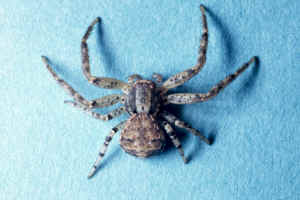
Wild Flowers and Their Associates Photos 081-100
A click on the number of a photo produces an enlargement to 800 by 600 pixels. A click on a photo produces a smaller enlargement.
Photo 081. Xysticus ferox (Comstock, p. 547) is a small crab spider with this as its standard coloration.
Photo 082. Xysticus luctans (Comstock, pp. 549-551) is a small crab spider. The crab-like reach of its legs is useful for grabbing its prey and holding on until its venom has its effect. The bees and other insects that crab spiders attack in flowers are generally quite a bit larger than the crab spider itself. Thus, crab spiders can easily lose part of a foreleg even when their victim is overcome. Given time, they have the ability to regrow missing parts of limbs.
Photo 083. Peucetia viridans (female) (Comstock, pp. 666-667) from Highland County, Florida, is one of the Lynx spiders. They catch their prey in several ways. They can run rapidly about plants and jump from branch to nearby branch; and they can wait in ambush (like a wildcat) and drop down on its prey. This species has an interesting eye arrangement with two small eyes in front, then two larger eyes behind them, and a row of four eyes behind them. This is a large spider and it must have good vision as well as depth perception.
Photo 084. Peucetia viridans on Plumbago capensis in a park at Jacksonville, Florida in December of 1969. This spider can jump, it can run, and here it appears to be waiting in ambush. At that time, the Greyhound bus company had a rent-a-car service in Florida where for $45 one could rent a Chevrolet Nova or a Ford Pinto for one week without limitation as to miles driven. The renter merely had the additional expense of gasoline and insurance. Even at that time it seemed like a bargain.
Photo 085. Danaus gilippus berenice at Buttonwood Canal in the Everglades.
Photo 086. The Queen Butterfly at Buttonwood Canal in the Everglades near Flamingo.
Photo 087. Heliconius charitonius tuckeri at the Gumbo-Limbo Trail in the Everglades during December of 1969. One of the most interesting impressions I recall from this particular vacation was the rapidity of the transition from broad daylight to complete darkness at this particular time of year. Namely, the conditions are such that the sun approaches the horizon perpendicularly and the transition from bright daylight to (moonless) darkness is essentially the time for the sun to move about one-half the arc it subtends. In any case, the Gumbo-Limbo Trail is in a shady hammock having dense foliage (Gumbo-Limbo, Mahogany, etc.) and in poor lighting this Zebra butterfly has a magical quality as it glides closely by below our height with very slow wing beats where only the yellow stripes are visible. A person venturing into the Gumbo-Limbo Trail somewhat before sunset in December should carry a flashlight.
Photo 088. Zebra Butterfly illuminated from below with a strobe light as darkness approached in the Everglades' Gumbo-Limbo Trail of 1969. From above its stripes are yellow. From below they appear mostly white.
Photo 089. Zebra Butterfly in Everglades. This is how the yellow stripes appear as darkness approaches.
Photo 090. Agraulis vanillae nigrior in the Everglades of 1969. It is commonly called the Gulf Fritillary.
Photo 091. The Gulf Fritillary at the Buttonwood Canal near Flamingo in the Everglades of December 1969.
Photo 092. The Gulf Fritillary at the Buttonwood Canal near Flamingo in the Everglades of December 1969.
Photo 093. The Gulf Fritillary at the Buttonwood Canal near Flamingo in the Everglades of December 1969.
Photo 094. Phaeon Crescent in the Everglades of 1969 near Pa-hay-okee.
Photo 095. The White Peacock Butterfly of South Florida during December of 1969.
Photo 096. Anartia jatrophae guantanamo. The White Peacock Butterfly, South Florida, December, 1969.
Photo 097. The White Peacock Butterfly, South Florida, December, 1969.
Photo 098. The White Peacock Butterfly, South Florida, December, 1969.
Photo 099. Ruddy Dagger-Wing, South Florida, December, 1969.
Photo 100. Marpesia petreus thetys is more commonly called the Ruddy Dagger-Wing. The photo was taken in South Florida during December of 1969. The flower in Photos 097-100 is Bidens leucantha.
Return to starting page for Wild Flowers and Their Associates